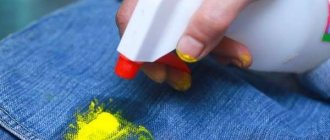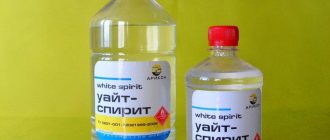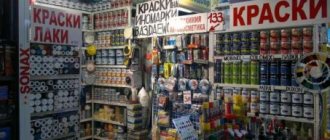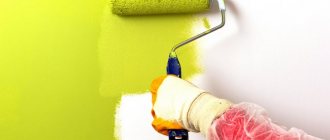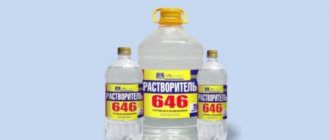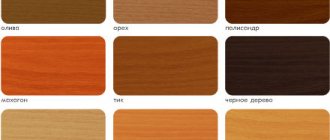Painting is required for a variety of surfaces, and is resorted to quite often, but in order for the paint to apply beautifully and be distributed evenly, it must be of the correct consistency. If the paint turns out to be too thick, then dilution of the composition is necessary. It is important to choose the right way to dilute the paint so as not to lose its properties and get a high-quality result. How to dilute paint will be discussed further.
Instructions on how to properly dilute paint
Paint that has become thick, dense and heavy over time will have poor adhesion to the surface during use.
- Its consistency becomes lumpy, and this will not allow you to get an even, beautiful coating.
- Otherwise, applying such paint will be quite problematic, and over time it will completely fall off the wall surface.
- To prevent this from happening, and to ensure that the work progresses easily and quickly, the paint must be diluted before use.
When diluting the material, it is very important not to overdo it, otherwise it will lose its elasticity and become too liquid. In addition, the paint will take a long time to dry, its coating will be sticky and short-lived. As a result, both the material and the surface will be hopelessly damaged.
In what cases is it necessary to thin the paint?
During long-term storage, the material can thicken even in a tightly closed container, and even more so if it was stored open. This paint cannot be applied with a roller or brush.
If the paint is applied unevenly, rolls off, forms sagging and brush marks, then it must be diluted.
If work is performed on large surfaces, the paint can be diluted, thereby increasing its volume. When thinning the paint, it is important to monitor its viscosity and not allow the consistency to become too runny.
Viscometer
p, blockquote 12,0,0,0,0 —>
This is a device with which you can measure the viscosity of paints and varnishes. Using a viscometer, you can accurately bring paint or varnish to the desired fluidity. There are expensive viscometers designed for use in laboratories, and there are also cheaper options that can be used to determine the viscosity of car paint. It is quite possible to use inexpensive plastic viscometers.
p, blockquote 13,0,0,1,0 —>
Measuring viscosity is very simple. You need to mix the paint in the right proportions. If bubbles appear, you need to wait until they disappear. Next, the viscometer is immersed in paint and filled to the brim, then the device is raised up so that paint and varnish material flows from the hole below. At the same time, you need to start the stopwatch. As soon as the steady flow of paint stops and it begins to interrupt and drip, the stopwatch must be stopped. This will be the viscosity data you need. There are special tables in which you can find data on the viscosity that must be in order to use paint with a spray gun that has a nozzle of a certain size.
p, blockquote 14,0,0,0,0 —>
p, blockquote 15,0,0,0,0 —>
Temperature affects the viscosity of paints and varnishes. The lower the temperature, the more viscous the paint becomes, and vice versa, the higher the temperature, the thinner the paint. Before dilution and use, paint and varnish must be at normal temperature.
p, blockquote 16,0,0,0,0 —>
To dilute paints and varnishes, you can use special measuring containers. Such containers have a scale. Thus, you can breed not “by eye”, but quite accurately.
p, blockquote 17,0,0,0,0 —> p, blockquote 18,0,0,0,1 —>
More interesting articles:
3 Comments
I still have a scraped base left after painting.
Please tell me: 1. Does the paint have an expiration date in this condition: it is stored in an ordinary plastic glass, the storage temperature is approximately +20
How to dilute paint (types of solvents)
There are special tools that help achieve the desired consistency of the material.
They differ in evaporation rate:
- Universal. These include compositions suitable for various paints. Suitable for work at any time of the year.
- Evaporates quickly. Such thinners help the paint dry quickly, which allows you to work with paint at low temperatures in the autumn-winter period.
- Slowly evaporating. Suitable for the hot season. Thanks to its low volatility, the paint becomes elastic, making it easy and pleasant to work with.
Thinners also differ in chemical properties:
- Hydrocarbon-based thinner: gasoline, kerosene, White Spirit and others;
- Thinners containing xylene, toluene, alcohols, ketones and ethers.
Solvent properties
Turpentine has a strong specific odor because it contains pine resin. For this reason, it should be used outdoors.
- White spirit preserves the original paint color and elasticity. It functions as both a paint thinner and a solvent, so it is convenient to clean the tool after work.
- Solvent 647 contains chemical components, which is why it has a strong, persistent odor. When working with it, you must ensure good ventilation. To achieve good paint uniformity, you need to mix it thoroughly.
- Gasoline and kerosene are a budget diluent option and have a simple composition. But at the same time, they are toxic flammable materials that require precise mixing proportions with paint.
- Drying oil is an oil-based thinner. Suitable for any type of paint. Together with paint it gives a durable and elastic coating.
- Water is suitable as a solvent for water-based paints.
General information
Purpose of solvent
Due to dilution, the dye will be much better placed on the surface in an even and thin layer. Even the specifics of the work also depend on the physical properties of certain coloring compositions. If a spray gun is used as the main working tool, then the paint for painting vehicles should be diluted to a liquid state. This will allow the coloring material to pass through the spray nozzle better. When working with a brush, the viscosity of the paint must be lower. The composition must also dry quickly so that smudges and other defects appear on the body. In order to minimize the cost of purchasing the required materials and at the same time not lose the quality of painting, you should know how to properly dilute the paint, depending on its chemical composition.
Composition of automobile paints
All paints for painting cars, as well as enamels, have three main components:
Pigment is a powder-type substance that will give the paint the desired color.- The base is a binder type - it helps to retain the pigment and also ensures adhesion of the material to the surface.
- Solvent - through it the composition can be given the required consistency.
Different types of dyes have different physical characteristics - density, elasticity, degree of fullness, and also the hardness of the layer after drying.
How much solvent is needed
All manufactured paints differ in their composition, which is why there is no specific dilution measure.
But manufacturers recommend diluting no more than 5%. This is equivalent to the scheme: 50 milliliters per 1 liter of paint.
Video description
3 in 1 rust paint. Myth or reality?
LAKRA is a fairly large manufacturer and distributor on the Russian market. Primer-enamel 3 in 1 from LAKRA is at the same time not only an anti-corrosion, but also a decorative coating, where all shades are provided according to the line (requirements) of the RAL table. It is very important that after final hardening, this paint and varnish material forms a glossy coating that is resistant to ultraviolet radiation, water and mechanical stress in the form of shock and friction. Like other protective enamel primer of this type, the composition can be applied to surfaces with a corrosive layer of up to 100 microns.
Latex enamel “Chief Technologist” for rust is diluted with water Source kraski-net.ru
How to properly dilute paint
To work, you will need a rectangular container. It is more convenient to dilute and mix paint.
It is important that the container has a streamlined shape, because material can accumulate in the corners, resulting in a heterogeneous mass.
- It is necessary to prepare a measuring cup with clear measuring markings.
- Next, mix the paint thoroughly; you can use a wooden spatula for this.
- Pour in the thinner in a thin stream, while simultaneously stirring the material, and evaluate the resulting consistency.
- If it has a moderately viscous and fluid composition, then the paint is ready for use.
Useful tips from a painter
After opening the container, the paint must be thoroughly mixed and then its condition must be assessed. During storage, it could separate, thicken and clump, and some of its components could sink to the bottom.
- Before you start thinning the paint, it is important to check its components for compatibility in order to avoid oxidation of the material. To do this, pour a little paint into a tray and dilute it with the chosen product. If the material has curled, it should not be used.
- It is better to prepare a small amount of material, this will help you not make mistakes in the calculations and not spoil the material.
- When working with solvents, you should take safety precautions; for this you need to use safety glasses, gloves, a respirator and work clothes. Good ventilation in the room will also be required, since these products are toxic and can adversely affect human health.
- Over time, the paint may thicken again, in which case the solvent can be used again.
- Paint that has dried and become as strong as stone should be diluted with the necessary product and left for two to three days. After this, mix thoroughly and evaluate its condition. If the paint has become more viscous and viscous, then it can be used to cover surfaces: greenhouses, garages, workshops, etc.
Thinning paint is a simple, but quite responsible process. It is important to monitor the consistency and strictly adhere to the manufacturer's recommendations.
Do not forget about safety measures, as toxic fumes from paint and thinners can negatively affect human health.
Consumption
To understand how much solvent is required for the entire volume of paint, you need to know the average consumption. It is important to comply with the standards for the inclusion of substances in the paint, without exceeding the maximum amount, then the desired characteristics of the diluted paint will be maintained. It is better to use containers with markings to measure quantities.
The standards standardly indicate the ratio of the substance per kilogram of paint. And the percentage indication and quantity of production is per square meter of base that will be painted.
So for oil-based paints you will need 110g/sq.m. surfaces. Other options such as solvent will be added in equal quantities with the coloring matter.
The proportion is selected according to the type of paint, so it is better to look at the instructions from the manufacturer, where dilution options should be indicated. Then you can be sure that damage to the product will not occur, and the technical characteristics will remain at the required level.
The proportion is selected according to the type of paint, so it is better to look at the instructions from the manufacturer, where dilution options should be indicated.

